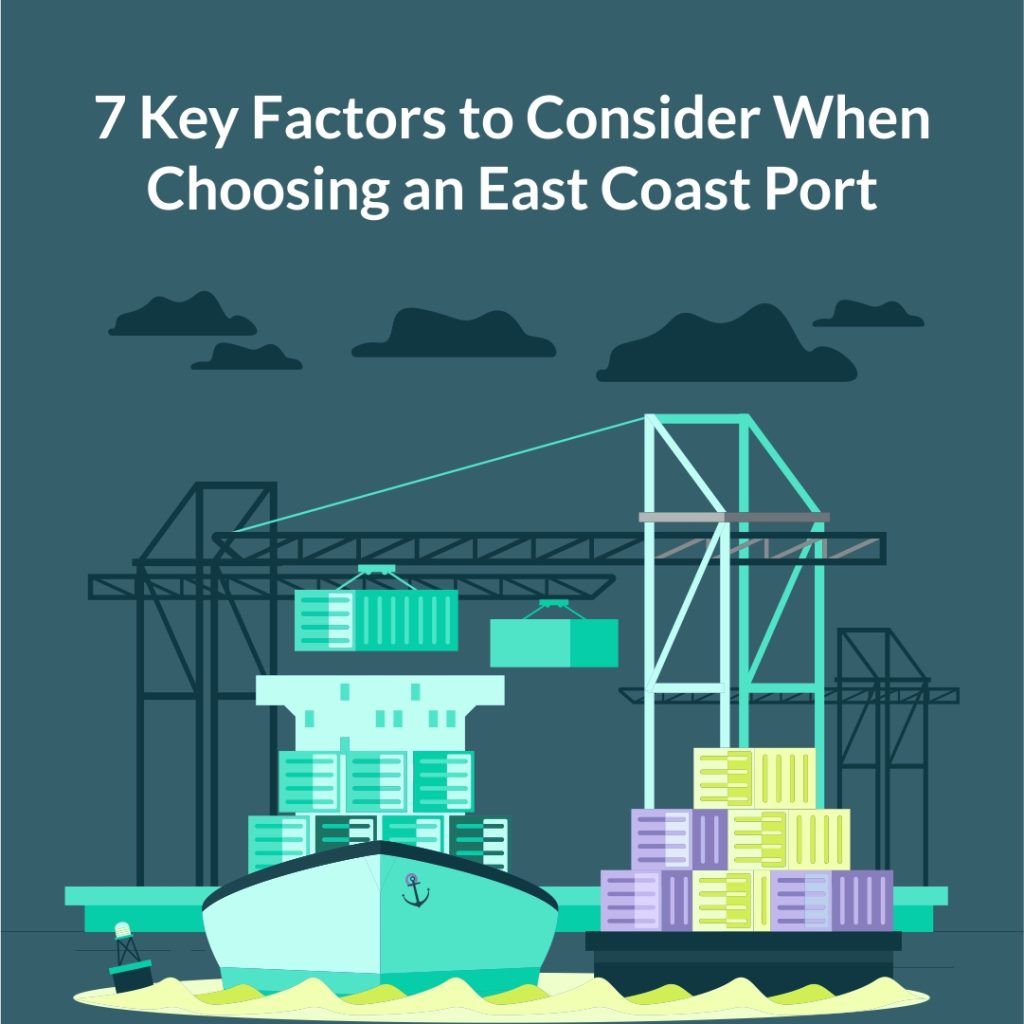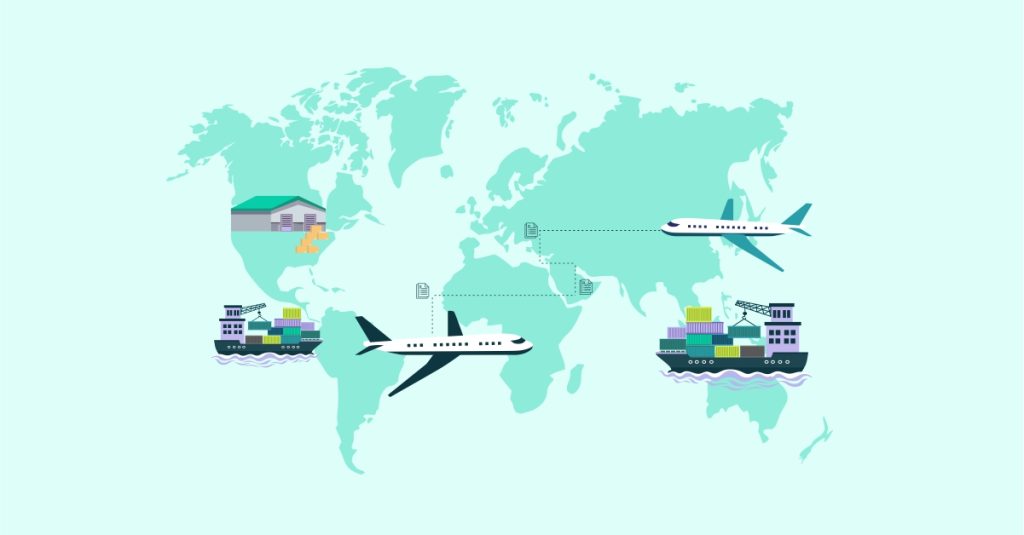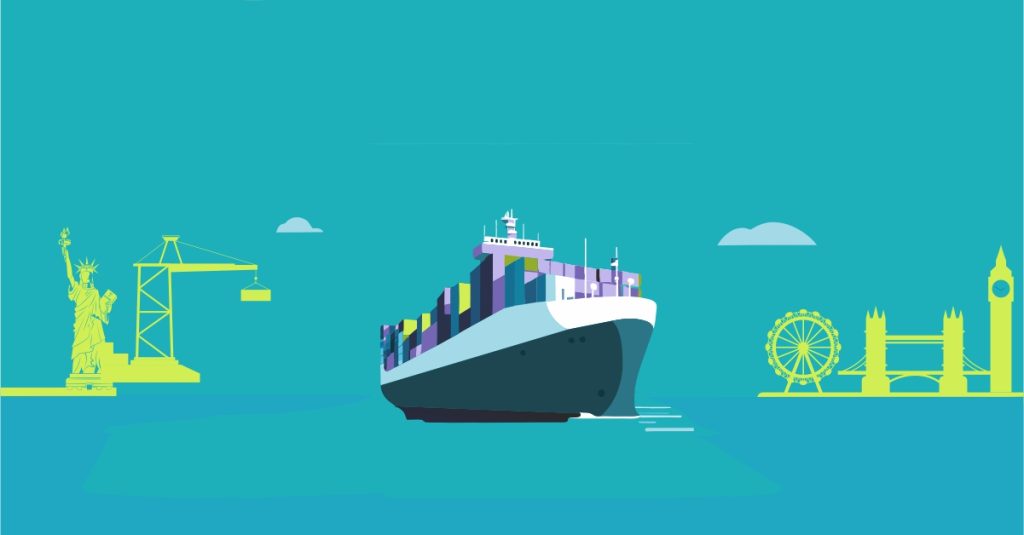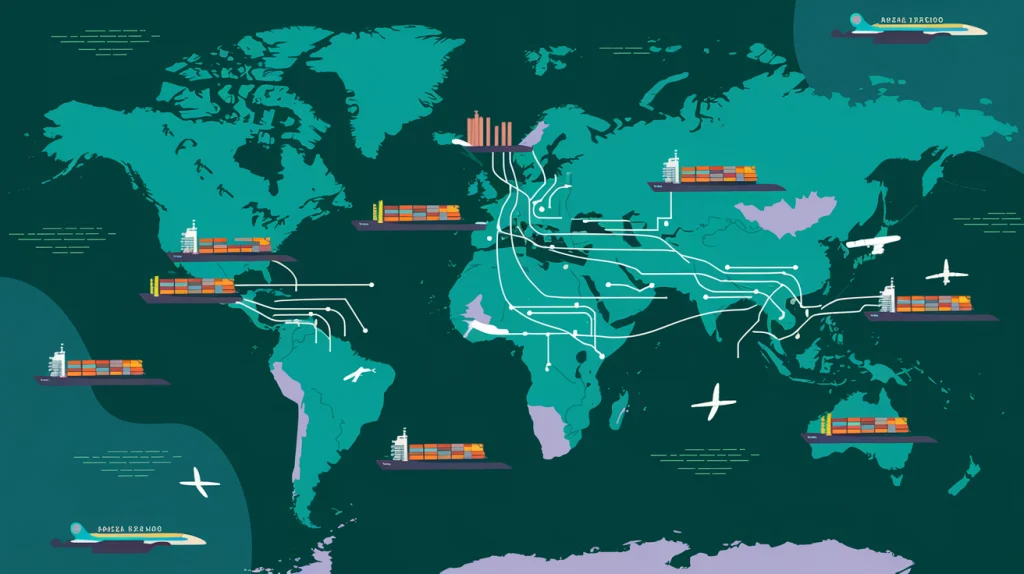Top 7 East Coast Container Ports: A Business Guide
International shippers are increasingly looking to the U.S. East Coast as a strategic gateway for global trade. Recent shifts in shipping patterns – from the expansion of the Panama Canal to diversification away from congested West Coast hubs – have elevated the importance of East Coast ports.
These ports serve as critical entry and exit points for goods moving between the United States and markets in Europe, Asia, Latin America, and beyond. Choosing the right East Coast port can significantly impact transit times, transportation costs, and supply chain reliability.
In this guide, we profile the top seven container ports on the U.S. East Coast and discuss how to evaluate them for your business needs. We also explore key factors in port selection and explain how partnering with a digital-forward freight forwarder like Unicargo can help optimize your logistics from port to final destination.
Port of New York and New Jersey
Overview
The Port of New York and New Jersey is the busiest container port on the U.S. East Coast, handling nearly 9.5 million TEUs (twenty-foot equivalent units) in 2022. This port complex – which includes major terminals in Newark, Elizabeth, and Staten Island – rivals even the largest West Coast ports in volume and capabilities.
In fact, New York/New Jersey briefly became the busiest port in the nation in 2022 by cargo volume, underscoring its strategic importance. With a deep harbor (50 feet) and the raised Bayonne Bridge enabling clearance for ultra-large container ships, the port routinely handles massive vessels from Asia and Europe.
Strategic Value
For businesses, Port of NY/NJ offers unparalleled access to the dense consumer markets of the Northeast U.S. Its proximity to New York City and major inland metros (Boston, Philadelphia, Toronto, etc.) makes it ideal for importers targeting retail distribution centers and e-commerce fulfillment in the region.
The port is well-connected by extensive rail (ExpressRail on-dock systems) and highway networks, facilitating efficient inland transport. A wide range of global shipping lines call at NY/NJ, providing frequent sailings from Europe, India, China and beyond. Shippers moving high volumes or requiring multiple weekly vessel options often find this port advantageous.
While congestion can occur during peak periods, ongoing investments in infrastructure and technology continue to improve efficiency. Overall, the Port of New York and New Jersey is a heavyweight gateway perfect for those needing capacity, carrier choice, and direct reach into the U.S. East Coast’s largest markets. (Notably, Unicargo has a physical presence in New Jersey, reflecting the port’s importance – more on that later.)
Port of Savannah
Overview
The Port of Savannah in Georgia is the second-busiest U.S. East Coast container port and one of the fastest-growing. In 2022, Savannah handled a record 5.9 million TEUs of container cargo, reflecting a steady climb in volume as more shippers route goods to the Southeast. The port’s Garden City Terminal is North America’s largest single-terminal container facility, known for its efficiency and room for expansion.
Savannah’s harbor has been deepened to about 47 feet, allowing it to accommodate large post-Panamax ships, and further berth improvements are underway. The port authority has aggressive expansion plans to boost annual capacity to 7.5 million TEUs by 2023 and up to 9 million by 2025, ensuring that Savannah can handle future growth.
Strategic Value
Savannah’s key advantage is its strategic location for serving the U.S. Southeast and beyond. It is a prime gateway for containerized imports from Asia (via the Panama and Suez Canals) destined for markets like Atlanta, Charlotte, and the Midwest.
The port’s rail connectivity is particularly strong – the Mason Mega Rail Terminal links Savannah to major inland hubs (Chicago, Memphis, Dallas, etc.) with double-stack train service, allowing shippers to reach deep into the U.S. interior efficiently. Many retailers and manufacturers have built distribution centers near Savannah due to the port’s reliability and lower congestion relative to some larger ports.
Savannah is also known for faster truck turn times and ample warehousing space in the region. For businesses, this means lower drayage costs and the ability to scale operations. If your supply chain feeds the Southeast or requires a high-throughput, well-run port with ongoing expansions, Savannah is an excellent choice.
Port of Virginia (Norfolk)
Overview
The Port of Virginia, centered on the Norfolk harbor in Hampton Roads, is a technologically advanced port complex that handled about 3.7 million TEUs in fiscal year 2022 – a record high for the port. Comprising multiple terminals in Norfolk, Portsmouth, Newport News, and an inland facility in Richmond, the Port of Virginia has made significant investments to handle big-ship volumes.
The port is currently deepening and widening its channels to at least 55 feet by 2025, which will give it the deepest harbor on the East Coast (surpassing even New York and Charleston) to accommodate super-post-Panamax vessels. The port features modern infrastructure, including semi-automated terminals and an array of new ship-to-shore cranes. It was also one of the first East Coast ports to be big-ship ready after the Panama Canal expansion, partly due to not having any air draft restrictions (there are no bridges blocking large ships).
Strategic Value
Port of Virginia is often favored for its efficiency and excellent intermodal connections. Two major railroads (CSX and Norfolk Southern) provide on-dock rail service, making it easy to move containers by train to inland markets like the Ohio Valley, Carolinas, and the Midwest.
The port even operates the Virginia Inland Port in Front Royal, VA, extending its reach by rail into the Washington, D.C. area and Appalachian region. For shippers, this means cargo can be transferred from vessel to rail and be inland swiftly, reducing reliance on long-haul trucking.
Virginia’s terminals are known for fast turnarounds and less congestion, which can translate to more predictable delivery schedules. The port is geographically well-positioned for transatlantic trade; many services from Europe call at Norfolk en route to or from other U.S. ports. It’s also a significant export gateway for commodities like agricultural products and machinery from the region.
If your business values deep-draft capabilities (for the largest vessels), advanced port tech, and strong rail connectivity, the Port of Virginia is a compelling option.
Port of Charleston
Overview
The Port of Charleston in South Carolina has long been a major East Coast trade hub and continues to expand. In 2022, Charleston moved a record 2.8 million TEUs through its terminals, reflecting modest growth and a healthy share of East Coast trade. Notably, Charleston now boasts the deepest harbor on the East Coast at 52 feet (completed ahead of schedule in 2022), enabling it to seamlessly handle fully laden super-ships regardless of tides.
The port operates out of two main container terminals (Wando Welch and North Charleston Terminal) and recently opened a state-of-the-art Hugh K. Leatherman Terminal, adding significant capacity. South Carolina Ports Authority has invested heavily (over $2 billion in recent years) in infrastructure, including modernizing equipment and developing an intermodal rail yard to further enhance efficiency.
Strategic Value
Charleston’s location and capabilities make it particularly valuable for shippers in the Southeast and Midwest. It serves as a global gateway for South Carolina’s robust manufacturing sector – for example, automotive and aerospace companies export vehicles and components through Charleston’s docks.
The port’s efficient handling of exports and imports means it can balance inbound flows with outbound, an important factor for container availability and cost. Companies importing retail goods or industrial supplies for the Carolinas and Tennessee regions often leverage Charleston for its relatively fast vessel berthing and unloading times (a result of recent upgrades and less congestion).
Charleston also operates Inland Port Greer and Inland Port Dillon, which connect via rail to the main port, helping shippers in interior points like Atlanta or Charlotte move containers to/from the port with ease.
If your supply chain involves the Carolinas, Georgia, or even Midwest markets like Nashville, Charleston can be an efficient port of entry/exit. Its combination of deep harbor, new capacity, and intermodal links provides flexibility and room to grow with your business.
Port of Baltimore
Overview
The Port of Baltimore in Maryland is a mid-Atlantic gateway known for its specialized capabilities and improving container volumes. In 2023 Baltimore’s public and private marine terminals handled a record 1.1 million TEUs, marking the first time it crossed the one-million mark in a year.
Baltimore has a 50-foot-deep container berth and is equipped with ultra-large Neo-Panamax cranes, allowing it to service some of the biggest container ships that traverse the Suez and Panama Canals. The port’s location is the farthest inland of the major East Coast ports (180 miles from the Atlantic, via the Chesapeake Bay), which positions it closer to the U.S. heartland.
Baltimore is also one of the most diversified ports: along with containers, it is the nation’s #1 port for automobile shipments (over 847,000 cars handled in 2023) and is a leading gateway for roll-on/roll-off cargo and bulk commodities.
Strategic Value
For businesses, Baltimore can be extremely attractive for reaching the Midwest and Northeast. Its inland location means shorter trucking distances to cities like Washington D.C., Pittsburgh, Cleveland and even Chicago compared to more coastal ports.
The port is connected by two Class I railroads (CSX and Norfolk Southern), and a long-awaited project to expand the Howard Street Tunnel for double-stack trains is underway, which will further enhance rail efficiency out of Baltimore. Shippers importing heavy machinery, vehicles, or needing robust handling of specialty cargo often choose Baltimore because of its expertise in those areas.
The port’s size is more modest, which sometimes results in faster customs clearance and less congestion on the terminals – a benefit if you are moving time-sensitive cargo. Baltimore offers several foreign trade zones and distribution facilities nearby, potentially reducing duty costs and easing last-mile logistics.
If your logistics strategy targets the mid-Atlantic population centers or you require a port experienced in handling diverse cargo types, Baltimore is a solid contender to consider.
Port of Miami
Overview
PortMiami (Port of Miami), in Florida, is the busiest container port in the state and a critical hub for north-south trade. Often dubbed the “Gateway to the Americas,” PortMiami is the foremost U.S. port connecting Latin America and the Caribbean. The port handles roughly 1.2 million TEUs annually in recent years and has capacity for more growth after completing a deep dredge project.
Miami’s harbor depth is about 50 feet, achieved by the Deep Dredge in 2015, which means it can accept large New-Panamax ships that transit the Panama Canal. The port is located on Dodge Island in Biscayne Bay, directly linked to the interstate highway via the PortMiami Tunnel, and has on-dock rail connections to the Florida East Coast Railway.
While Miami is globally famous for cruise traffic, its freight operations are highly advanced – featuring new gantry cranes, refrigerated cargo infrastructure, and direct ship services to dozens of ports in Central and South America.
Strategic Value
Companies that trade with Latin America (importing produce, beverages, raw materials or exporting U.S. goods to those markets) often find Miami indispensable. The port’s frequency of service to the Americas is unmatched; multiple weekly feeder ships and mainline vessels connect Miami with ports in Brazil, Colombia, Dominican Republic, Panama, and more. This results in shorter transit times for regional trade than routing via an out-of-region port.
Miami also has a strong cold chain logistics ecosystem – it’s equipped to handle refrigerated containers and has nearby cold storage warehouses, which is crucial for perishables like fruits, seafood, and pharmaceuticals.
For Asian or European imports destined for Florida or the Southeast, Miami is one option (though Port Everglades and Jacksonville are also in Florida and sometimes used interchangeably for certain logistics strategies). Miami’s edge, however, is its international air cargo hub (Miami International Airport) and its role as a consolidation point for Latin American distribution.
Shippers can bring in cargo by ocean, then easily redistribute by air or smaller vessels to island nations and vice versa. If your business has a strong Latin American connection or needs a port with world-class reefer handling and connectivity, Miami stands out as the port of choice on the East Coast.
Port of Philadelphia
Overview
The Port of Philadelphia (PhilaPort) is an emerging East Coast container port that has been investing heavily to increase its capacity and capabilities. In 2022, PhilaPort handled a record 762,000 TEUs, continuing its upward trajectory of growth. While smaller in volume than the other ports on this list, Philadelphia has carved out a niche in several areas.
The Delaware River main channel deepening to 45 feet was completed a few years ago, now allowing larger ships to call at Philadelphia than was possible in the past. The port has modernized its Packer Avenue Marine Terminal with new super-post-Panamax cranes and updated warehousing.
Philadelphia is known for its Foreign Trade Zone status and numerous cold storage facilities, making it a prime gateway for certain imports like fresh produce. The port authority’s long-term development plan (“Destination 2040”) aims to roughly double container capacity to about 1.5 million TEUs, indicating a strong commitment to attracting more global services.
Strategic Value
For shippers, Philadelphia offers some distinct advantages. Its location in the Northeast corridor (between New York and Washington) means access to over 50 million consumers within a day’s drive. Yet, it often has less congestion and lower port fees than the bigger hubs, which can translate into cost savings and quicker truck turn times.
Philadelphia has become a leading entry point for refrigerated and perishable cargo – for instance, fruit from South America and meats or juices from Europe frequently come through Philly due to the presence of specialized handlers and USDA inspection facilities geared for food imports. If your supply chain involves temperature-controlled goods or you want an alternative Northeast port to avoid the busiest New York/Newark terminals, Philadelphia is an attractive option.
The port’s size can mean a more personalized service and potentially flexible scheduling for shippers. With new direct Asian services now calling (thanks to the deeper channel), Philadelphia is expanding beyond its regional role to join the roster of full-service East Coast container ports. It’s an especially good choice for businesses in Pennsylvania, Southern New Jersey, and the mid-Atlantic that want to minimize inland transport from coastal ports.

7 Key Factors to Consider When Choosing an East Coast Port
Selecting the optimal port of entry or exit on the East Coast depends on a company’s specific logistics needs. Here are key factors global shippers and supply chain decision-makers should evaluate:
- Proximity to Markets and Suppliers: Consider the location of your distribution centers, factories, and end customers. A port closer to your cargo’s final destination can reduce overland transportation time and cost. For example, if your inventory needs to reach Northeast U.S. cities, a northern port like New York/New Jersey or Philadelphia could be more efficient, whereas cargo bound for the Southeast might favor Savannah or Charleston.
- Infrastructure & Capacity: Examine each port’s capabilities – channel depth, crane size, terminal capacity, and historical throughput. Ports that can handle larger ships and higher volumes (e.g. NY/NJ or Savannah) are ideal for high-volume importers, but smaller shippers might prioritize a port’s efficiency over sheer size. Ensure the port can accommodate your cargo type (standard containers, out-of-gauge loads, reefers, etc.) without delays. A port investing in expansion (such as adding berths or cranes) can also be a sign it will handle future growth in your volumes.
- Intermodal Connectivity: A port is only as good as its connections to your origin or destination. Evaluate the availability of rail services and major trucking routes from the port. If you need to move containers to inland cities, ports with on-dock or nearby rail (Norfolk, Savannah, Charleston, Baltimore) can streamline the transfer and potentially lower drayage costs. Access to major highways is equally important for trucking – consider congestion on those routes as well. The better a port’s connectivity, the more easily your goods flow through the supply chain.
- Carrier Services and Sailing Schedules: Different ports have different route networks. You should verify that the port you choose is regularly served by carriers that go to your key overseas ports of loading or discharge. For instance, if you import heavily from South America, Miami or Philadelphia might have more direct services, whereas Asia-Europe strings often route via New York, Savannah, or Norfolk. A port with multiple weekly sailings to your origin/destination region offers flexibility and potentially shorter transit times. Working with a freight forwarder can help map which ocean services call where and how that impacts total transit.
- Customs and Regulatory Considerations: U.S. Customs and Border Protection (CBP) operates at all major ports, but clearance times and processes can vary. Some ports may offer a Centralized Examination Station (CES) on site or have specialized customs programs (like the advanced screening for perishables in Philadelphia). Additionally, ports located within Foreign Trade Zones (FTZs) or offering FTZ-designated warehouses can allow you to defer or reduce duties, which might be beneficial for certain import/export strategies. If quick customs clearance is critical for your business (to prevent supply chain delays), look at metrics like average cargo dwell time or whether the port community system allows for efficient document handling.
- Port Fees and Handling Costs: While often not the first thing considered, the cost differentials between ports can add up. Each port has its tariff for handling, security fees, wharfage, etc. Additionally, trucking costs (per mile) and rail rates will depend on the distance from the port to your facilities. When comparing options, factor in the total landed cost: ocean freight differences, port charges, and inland delivery expenses. Sometimes a slightly more distant port with lower handling fees and less congestion can be more cost-effective overall than the nearest port that has higher fees or frequent delays. Analyze demurrage and detention history as well – a port where containers flow out smoothly will save on these extra charges.
- Reliability and Risk Factors: Finally, consider the port’s track record and any risk factors. This includes congestion history, labor stability (e.g. labor strikes or slowdowns have historically affected West Coast ports more than East Coast, but it’s worth monitoring local conditions), weather-related disruptions (hurricanes can affect the Southeast – e.g. Miami, Charleston – while winter storms might impact the Northeast ports), and even port security issues. A port with a strong reputation for reliability, good communication, and rapid recovery from disruptions will give you peace of mind. It can be useful to consult performance data or ask logistics partners about experiences at each port.
In many cases, large importers use multiple ports to diversify risk and optimize distribution (for example, splitting volume between a Northeast port and a Southeast port). The key is to have a rationale for each port in your strategy, ensuring it serves your supply chain efficiently.
How Unicargo Optimizes Port Selection and Supply Chain Logistics
Choosing the right port and managing all the moving parts of global shipping can be complex. This is where partnering with a knowledgeable, tech-driven freight forwarder like Unicargo adds significant value. Unicargo is a freight forwarder with a global presence (headquartered in New Jersey, with regional offices in Asia and Europe) that specializes in end-to-end logistics planning. Here’s how Unicargo’s expertise and platform support businesses in making the most of East Coast port options:
- Port Selection and Route Optimization: Unicargo’s team leverages deep industry experience and data insights to help shippers evaluate which port of entry or exit best suits a given shipment or supply chain. Rather than leaving clients to navigate dozens of carrier service maps, Unicargo can analyze routes, transit times, and costs across multiple East Coast ports. For example, if an importer’s goal is to minimize transit time from China to a warehouse in Atlanta, Unicargo might compare Savannah vs. Norfolk vs. New York, factoring in ocean schedules and inland trucking/rail time. By presenting these options, Unicargo empowers businesses to make informed decisions. This route optimization extends to advising on multi-port strategies as well – Unicargo can coordinate split shipments arriving at different ports to expedite delivery or avoid regional disruptions.
- Customs Compliance and Clearance: Unicargo provides robust customs brokerage and compliance support to ensure your cargo clears promptly and complies with all regulations. Our logistics experts handle documentation, tariffs, and coordination with U.S. Customs and Border Protection, so you don’t have to juggle separate customs brokers. In practice, this means that whether your container is arriving in Miami or Philadelphia, Unicargo will prepare and file the necessary import entries, manage any customs exams, and facilitate duties payment or FTZ handling if applicable. This level of oversight is especially valuable if you’re importing goods that require special attention (such as FDA-regulated items, textiles with quotas, or hazardous materials).
- Digital Platform for Visibility and Control: One of Unicargo’s differentiators is its modern digital freight forwarding platform. Shippers get access to a user-friendly online dashboard that provides full visibility into their shipments in real time, from origin to port to final destination. Through this platform, you can track vessel progress, see when your container is discharged at the port, and receive alerts for key milestones (customs cleared, available for pickup, out for delivery, etc.). This level of transparency is crucial for supply chain managers who need to plan downstream activities like staffing warehouses or scheduling last-mile delivery. By combining technology with personal support (each client has a dedicated logistics manager at Unicargo), Unicargo ensures that you have both the tools and the expert guidance to keep your supply chain running smoothly.
- Global Network and Local Expertise: With operations across three continents and a headquarters near the Port of New York/New Jersey, Unicargo offers both global reach and local know-how. This means if you’re shipping from Shanghai or Rotterdam to an East Coast port, Unicargo’s team overseas can coordinate directly with carriers and origin handling, while our East Coast team on the ground in New Jersey can personally oversee the arrival, customs process, and onward delivery. Such coverage is invaluable for troubleshooting and agility.
By partnering with Unicargo, businesses gain a holistic logistics solution that covers every aspect of shipping via East Coast ports – from the initial strategic decision of which port is best, to the tactical execution of moving the goods through that port efficiently, and finally to delivering freight with full visibility and compliance.
Conclusion
In global trade, seemingly small decisions – like which U.S. entry port to use – can have outsized effects on supply chain performance and business profitability. The seven East Coast container ports profiled above each offer distinct strengths, from the massive capacity of New York/New Jersey to the regional specialization of Philadelphia. By understanding the strategic value of each port and carefully evaluating factors such as location, infrastructure, connectivity, and cost, companies can align their port choices with their business goals. The right port can mean faster time-to-market for products, lower inland transportation expenses, and greater resilience against disruptions. Conversely, a mismatched port choice might lead to avoidable delays or higher logistics costs.
Ready to enhance your East Coast shipping strategy? Leverage the power of a reliable freight forwarder to unlock efficiencies and peace of mind. Contact Unicargo today to discuss your logistics challenges and discover how our team can help optimize your routes, reduce transit times, and give you end-to-end visibility in every shipment. Making the right port choices – and having the right partner – will keep your global supply chain moving forward smoothly and competitively.


